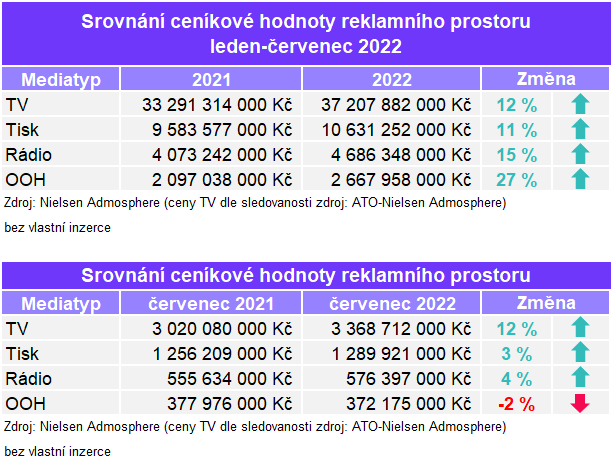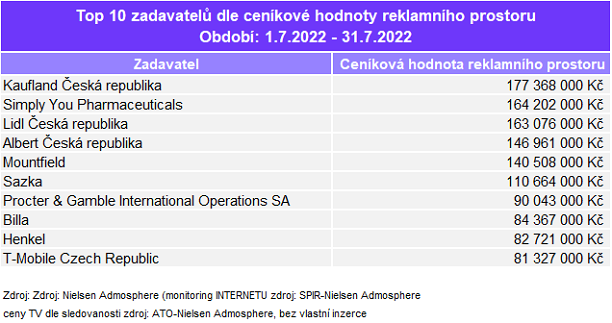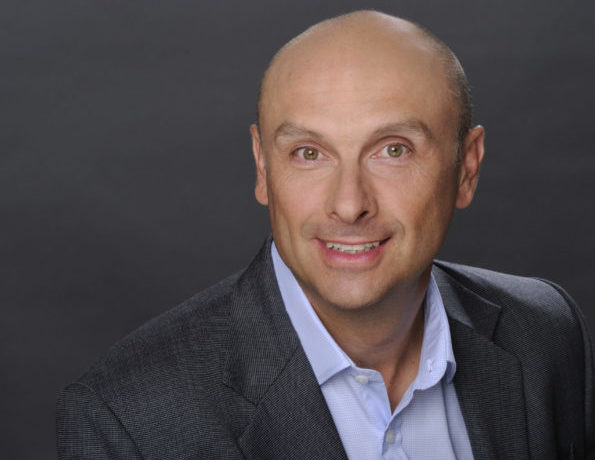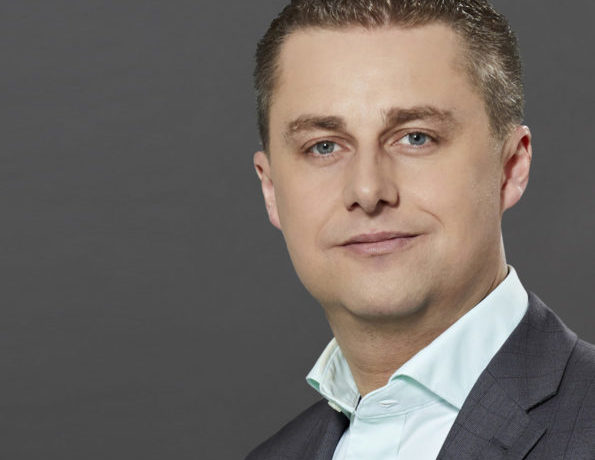More positive topics or tips on how to cope with the rising cost of living. That, too, is a recipe for responding to people’s frustration with the overabundance of negative events, according to TV Nova news director Kamil Houska.
Television news coverage in recent years has been marked primarily by events related to the coronavirus pandemic. This February, the war in Ukraine became the main topic. Both incidents have affected both the way television news is covered and the media behaviour of viewers. The steep interest in information has been replaced this spring by the strain of the overload of negative events, accompanied by a partial flight from television coverage. “On the other hand, there is a growing interest in news on the Internet and we see that TV and Internet news are sought out by different groups of viewers,” says Kamil Houska, director of TV Nova’s news department, who believes that viewers will return to TV news in the autumn. He sees the future of news in its availability on different platforms for different groups of viewers. “We are already fighting for young people to stay with us when they get older,” he says, pointing out that Nova’s TikTok account, which is aimed at the younger generation of “teenage” users, has been very successful.
TV news had very strong themes in the last two years, first it was covid, and since February this year it has been the Russian aggression in Ukraine. These are very serious topics that can be stressful for viewers. How has that affected interest in your news coverage?
We saw that the interest in information was high during the time of the covid pandemic. The fact that people were forced to spend time at home contributed to this, and as a result, TV ratings increased. This was the case for the whole market, not just our news segment. But now the situation is different. In the last two to three months there has been a decline in news viewership across the board. Leaving aside the fact that we are in the middle of summer, when TV ratings are always lower, the decline, according to our analysis, is linked to the fact that some people have deliberately crowded out news. We’ve talked to psychologists and sociologists about this, and they believe that after two years of people being stressed by covid and then the war in Ukraine, by the price hikes or energy security, they’ve tried to cope with the onslaught by running away from the news. For example, we’ve lost a few women in the newsroom and gained a few men. Sociologists believe that this is related to the fact that men in stressful situations tend to deal with further developments and the future, while women, at a certain stage when the stress is too much, feel more existential fears and try to push the negative things out. So now people are running away from the news because the news is negative and what is happening is negative.
Have you evaluated the need to respond to that kind of viewer behavior?
We have responded to it, of course, even though we cannot control the fact that negative things are happening that need to be reported. But we can influence the mix of news and what we emphasize. Rather than scaring people that price hikes are coming, we include stories where we try to give consumer advice and tips on how to deal with the situation. For example, we try to encourage people to save for top-ups so they are not caught out by high arrears in the autumn. We are also trying to look for more positive themes. The world is not black and white and it is not just full of bad things. We’re taking more notice of stories of interesting people and, for example, now in the summer we’re adding a travel window to every broadcast, tips for trips to give people a bit of a breather. We’re not going to change this era, but we’re seeing a lot of frustration in the community. That’s why we think people should get not only the necessary information about what’s going on tonight, but they deserve a picture of a more hopeful future for the world.
How have these two extraordinary events reflected in your work? What have you had to do differently or in a new way?
Every cloud has a silver lining. It taught us to react quickly, it exposed weaknesses we had that we were not prepared for in the long term. We lacked experience with a war situation this close to Europe. The trips of reporters with soldiers to Afghanistan or Iraq were different, because in Ukraine our reporters moved alone and without military help. We also lacked a number of things – for example, we did not have enough bulletproof vests, helmets, etc. We realised that we should introduce training for reporters in crisis areas, and we also saw how important psychological help was. We have learnt our lesson and as a result we are prepared for similar situations in the future.
I will come back to the fact that some viewers have started to avoid the news. What options do you have at that point? It’s hard to hide what’s going on…
We can’t really do that, but we have reduced the number of news pieces from Ukraine, for example. In the beginning we used to have ten to twelve of them, but now we have one to two most important news from Ukraine in one evening session. And there are days when we don’t cover Ukraine at all because there are no significant developments there. The interest of the audience is also not the same as in the beginning. It does not make as much sense to broadcast four or five reports every evening about shooting and bombing. People know that the war is on going, and if there are no tangible developments, I do not see the point. On the other hand, we are looking at Ukraine from other angles. We try to bring information about the integration of Ukrainians who have come to us, we bring news about how they are learning Czech or how their integration into the school system is being dealt with. We also try to help Ukrainians – for example, we still have a service for them in Ukrainian on TN.cz so that they can get all the information they need in their native language.
„Rather than scaring people that the price hikes are coming, we include reports where we try to give them consumer advice and tips on how to deal with the situation.“
Even before the war in Ukraine broke out, you were focused on sending your staff to Brussels. The war in Ukraine has probably overshadowed this, but how has the Brussels experience worked out for you?
The war in Ukraine has of course overshadowed everything, even covid seems to have ceased to exist. The whole world was interested in Ukraine. But we have had an excellent experience with the establishment of our headquarters in Brussels. At first we were a little worried about whether we would have enough topics. But the fears have not been confirmed and our staff is able to bring interesting topics from Brussels every day. We see this as a good step, because more and more important decisions are being made in Brussels. It has also helped us from the point of view of European politicians. By being accredited in Brussels, they see us as a relevant media outlet. It has opened the door to a number of interviews that we would not have been able to get before. Our aim is to report in an understandable way on what is happening in Brussels, and I believe we are succeeding.
Are you thinking of having a permanent Brussels correspondent?
We have never said for how long we are sending a staff to Brussels. We wanted to open up this reporting post. Coincidentally, it coincided with the Czech Presidency. But we didn’t say we were only going to Brussels for the duration of the Czech Presidency. That is not related to this. We now have a staff in Brussels and we are not thinking of abolishing it. It is not time-bound.
As far as Ukraine is concerned, you even had several reporters there. What is the situation today?
At one point we had up to three different crews in Ukraine, but now we have none. Around May, we decided that the war had reached a stage where we didn’t see any reason to keep the crews there.
How did you select the teams?
Each of our reporters could choose whether or not they wanted to go to the war zone. We didn’t force anyone, participation was purely voluntary. But I was pleasantly surprised by how many of them expressed interest in going to Ukraine. Perhaps seemingly surprisingly, women were among the first volunteers. It was essential for us as a TV organization to take good care of our people, whether it was with above-standard insurance, remuneration, or the facilities we had built for them. For someone with no experience, it was all done very professionally. And again, I must say that the way in which the crews of our television station and Czech Television treated each other was exemplary. I appreciated the fact that competitive rivalry goes aside in such situations and that we can help each other.
The things you had to do in connection with sending crews to Ukraine were – from what you have already indicated – quite complicated…
It was complicated and it was expensive. We needed to equip our people with filming equipment, bulletproof vests, helmets, we had to find large quantities of fuel in jerry cans, satellite phones or large cars in which you’d be able to sleep. Just to make the crews as self-sufficient as possible. It cost us several million crowns. We were also worried about what might happen, but now I have to say that I am not even aware that we had any problems – except for the time when our staff was detained by the army, but that was resolved, which is something that you cannot fully prepare for in advance.
Did you have to consult anyone about what things to provide for the staffs in Ukraine?
Partly. We have some experience because some of our reporters went to Iraq and Afghanistan, and I myself was in Bosnia as a young journalist. We had some idea of what needed to be provided and we also consulted military experts. But the rules that we set were also important. For example, the obligation to keep us informed of everything that was happening. Or knowing that you could come back home at any time and that there was no shame in that. Everyone knew that if they called me to say they wanted to come back, I respected that. Mental wellbeing is probably the most important thing to getting through this job.
Do you envisage sending crews to Ukraine again?
We are ready for that, but we are waiting for some impulse that will change the development fundamentally. It could be the end of the war and peace negotiations or a more massive offensive or possibly other changes in Ukrainian society. But at a time when much of the material is available through agencies, it makes no sense to keep crews in Ukraine. They would not have anything to produce. The stories and situations repeat themselves, and it makes no sense in the long run for commercial television to keep its crew on the ground for a long time in these circumstances. But if necessary, we are ready to go back within 24 hours.
Let us move on to other topics. Last year you started broadcasting from a new news studio. Are you happy with it?
We’re happy, we’ll tweak a few things, but it’s just small details. The news studio is working and now we are planning to invest in more studios. We also introduced a new sports studio before the summer and more will follow.
The studio for TN Live internet news was also newly established last year. In addition to the TV show, you are also expanding your internet news coverage. Do you plan to continue to do so?
I have long been an advocate that in a small country like the Czech Republic, building a purely news TV channel for commercial television is expensive and not effective. Its yield is, in my opinion, insufficient. That’s why we decided to go with the internet broadcast of TN Live. We are also linking it to a hybrid TV channel, from which you can click through to the live news feed. I think this is the future of news. It is more efficient and cheaper news, but at the same time it is produced in television quality and the viewer can watch it in situations where there is something to broadcast.
So you are still not considering a news TV channel?
We are not.
But does an internet news channel combined with a TV news channel have such an audience impact?
It’s not as if TN Live boosts TV viewership or vice versa. But it reaches a different group of people. When I talked about the fact that all TV stations saw a drop in evening news in May, on the other hand, we see that the traffic to our website TN.cz is increasing tremendously, and thus the viewership of the TN Live internet news. It’s different types of people that consume news. Our basic philosophy is to create news and deliver it in appropriate ways to different groups of viewers or readers. We put some on TV, some on the internet, some on social media. That’s the future. We just tailor the reporting we produce to where people receive it. That’s how we reach different audiences and increase the overall impact of the news.
But there’s no telling what the cumulative impact is…
It’s unfortunately difficult. A large number of viewers still watch TV, and with the internet, people change throughout the day and don’t watch news all day. Someone comes to the web 20 times a day and spends 10 minutes there. You can’t do a simple summation. But nowadays, it is not so important whether they see a story on TV, on the internet or on social media. Young people consume most news only on social media. If we are not on the networks, we will lose part of the audience because these people will not watch TV in the evening. Then there is a group of people who cannot function without television. There is another group that listens to the radio during the day, goes on the web and keeps up with the basic events of the day. Yet, in the evening they turn on the TV news because they are looking for a news summary of the day. Television news has the biggest impact on people despite the huge growth of the Internet.
Do you tailor the content and format of your coverage to the types of social media?
We tailor our posts to each social network. For example, we don’t expect the youngest generation of 15-year-olds to watch TV news in the evening. At the same time, we don’t want to lose the younger generation. That’s why we prepare news for them on TikTok, for example. When we started this, many people thought it was pointless. It’s not true. Yes, it’s a quick, short message, but we have hundreds of thousands of views on some of them. It’s not even true that young people aren’t interested in news. They’re just interested in something, maybe in a shorter, more entertaining way. Every social network is relevant for us to create news on. We’re successful with younger viewers on TikTok, and we believe that if we work with this generation, they’ll find us later in life – whether it’s online with TN Live or on TV with Television News. We are already fighting for the young to be with us when they are older.
„We’re successful with younger viewers on TikTok, and we believe that if we work with this generation, they’ll find us later in life – whether it’s online with TN Live or on TV with Television News.“
Are you preparing special broadcasts for the Senate and local elections?
We are preparing pre-election coverage for the Senate and local elections, but these are elections that are less central, so we will not focus on them as intensively as the parliamentary elections. The number one event for the second half of the year is the presidential elections, where we are preparing a number of surprises.
Finally, how do you estimate the development of audience interest in TV news in the second half of this year?
I believe that the decline in viewership that came in April and May this year is temporary. In June, the ratings started to improve, but then the holidays came. I think people will come back to TV news in the autumn.
Source: mediaguru.cz












